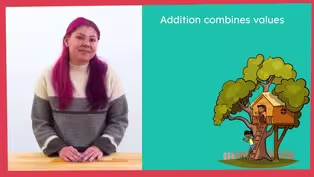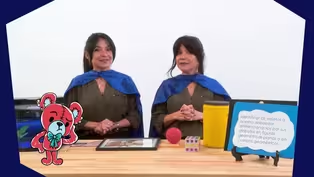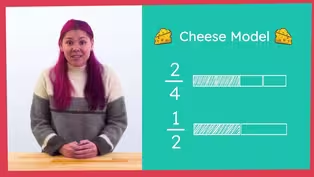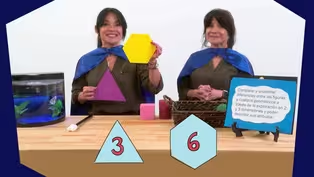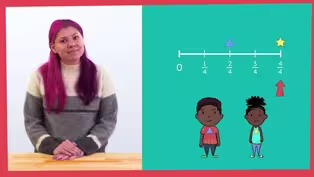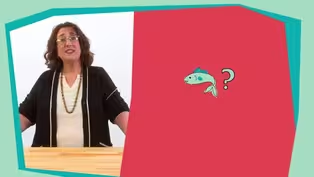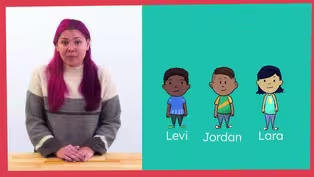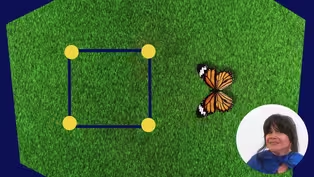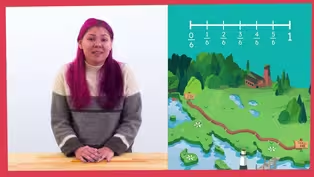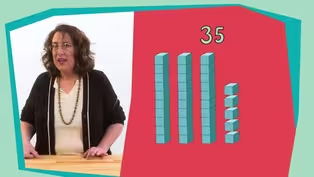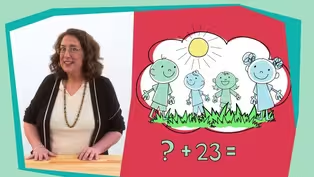
Episode 15 | Math Lessons
3/22/2021 | 28m 46sVideo has Closed Captions
Math lessons for early learners, led by NC teachers.
The first lesson (aimed at PreK-K learners) helps early learners understand the relationship between numbers and quantities. The second lesson (aimed at 1st-2nd graders) helps students recognize and combine groups of numbers. Classroom Connection is your At-Home Learning companion where children love to learn. All lessons are led by NC educators.
Problems playing video? | Closed Captioning Feedback
Problems playing video? | Closed Captioning Feedback
At-Home Learning Presents: Classroom Connection is a local public television program presented by PBS NC

Episode 15 | Math Lessons
3/22/2021 | 28m 46sVideo has Closed Captions
The first lesson (aimed at PreK-K learners) helps early learners understand the relationship between numbers and quantities. The second lesson (aimed at 1st-2nd graders) helps students recognize and combine groups of numbers. Classroom Connection is your At-Home Learning companion where children love to learn. All lessons are led by NC educators.
Problems playing video? | Closed Captioning Feedback
How to Watch At-Home Learning Presents: Classroom Connection
At-Home Learning Presents: Classroom Connection is available to stream on pbs.org and the free PBS App, available on iPhone, Apple TV, Android TV, Android smartphones, Amazon Fire TV, Amazon Fire Tablet, Roku, Samsung Smart TV, and Vizio.
Providing Support for PBS.org
Learn Moreabout PBS online sponsorshipMore from This Collection
Math lessons for early learners, led by NC teachers.
Video has Closed Captions
Math lessons for early learners, led by NC teachers. (28m 46s)
Video has Closed Captions
Math lessons for early learners, led by NC teachers. (28m 46s)
Video has Closed Captions
Math lessons for early learners, led by NC teachers. (28m 46s)
Video has Closed Captions
Math lessons for early learners, led by NC teachers. (28m 46s)
Video has Closed Captions
Math lessons for early learners, led by NC teachers. (28m 46s)
Video has Closed Captions
Math lessons for early learners, led by NC teachers. (28m 46s)
Video has Closed Captions
Math lessons for early learners, led by NC teachers. (28m 46s)
Video has Closed Captions
Math lessons for early learners, led by NC teachers. (28m 46s)
Video has Closed Captions
Math lessons for early learners, led by NC teachers. (28m 45s)
Video has Closed Captions
Math lessons for early learners, led by NC teachers. (28m 46s)
Video has Closed Captions
Math lessons for early learners, led by NC teachers. (28m 45s)
Video has Closed Captions
Math lessons for early learners, led by NC teachers. (28m 46s)
Providing Support for PBS.org
Learn Moreabout PBS online sponsorship[cheerful upbeat music] ♪ - Welcome to Classroom Connection.
I'm your host, Mr. R, and I'm also a teacher.
I hope you'll join me in the classroom as we learn from teachers all across this beautiful state of North Carolina.
[gentle music] - Hello super learners, Ms. M here.
I am so glad you're glad that you are here today.
Are you ready for another math adventure today?
[gentle music] Well let's get started.
♪ hello super learners how are you ♪ ♪ hello super learners how are you ♪ ♪ I'm so glad you're here today ♪ ♪ and I hope you feel the same ♪ ♪ hello super learners how are you ♪ How are you today super learners?
[guitar music] I feel startastic today, and I hope you do too.
[guitar music] Let's get started with our math power warm ups, counting up to 20, are you ready?
Here we go.
[guitar music] ♪ One, two, three, four, five, six, seven ♪ ♪ Eight, nine, 10, 11, 12 ♪ ♪ 13, 14, 15, 16, 17, 18, 19, 20 ♪ ♪ That was fun ♪ Well now it's time to snap count up to 20, ready?
Let's go, One, two, three.
[ finger snapping] Four, five, six.
[ finger snapping] Seven, eight, nine.
[ finger snapping] 10,[finger snaps] let's keep going.
11, 12, 13.
[ finger snapping] 14, 15, 16.
[ finger snapping] 17, 18, 19.
[ finger snapping] 20 yes, super learners are the best.
I'm feeling all warmed up, and I hope you are too.
One more time counting, but this time in Spanish.
[speaks in Spanish] Amazing!
Amazing super learners.
Now, let's time to review our colors, in English and in Spanish.
[gentle guitar music] [speaks in Spanish] Red.
[speaks in Spanish] Orange.
[speaks in Spanish] Yellow.
[speaks in Spanish] Green.
[speaks in Spanish] Blue.
[speaks in Spanish] Purple.
[speaks in Spanish] Brown.
[speaks in Spanish] Black.
[speaks in Spanish] White.
And [speaks in Spanish] Gray.
Look for these colors in the world today.
[gentle music] And now for our last math power warmup.
Time for the shape game, you'll see a shape, and then you say its name in English or Spanish.
[gentle music] [speaks in Spanish] Square.
[speaks in Spanish] Circle.
[speaks in Spanish] Triangle.
[speaks in Spanish] Rectangle.
[speaks in Spanish] Rhombus.
[speaks in Spanish] Trapezoid.
[speaks in Spanish] Hexagon.
[speaks in Spanish] Cube.
[speaks in Spanish] Cone.
[speaks in Spanish] Cylinder.
[speaks in Spanish] Sphere.
Mathtastic.
I hope you're all warmed up because it's time for our math mission of the day, come on let's check in with Sparkles of fish to see what our mission is today.
[gentle music] Hello Sparkles?
[gentle music] Thank you Sparkles.
Here it is, dear super learners.
Your mission today is to count to know the total number of objects.
There are two different mini missions today.
Where there are certain number of objects needed.
Count to find the right group of objects for each mini mission.
Well super learners, a total is an amount or number of something.
For example, I have one, two, three, four, five.
Five fingers on my hand.
Each finger is only one, but all together, I have five in total.
So today we will count different groups of objects to find the ones that have the totals that we need.
Super learners, I know we can do this mission.
[gentle music] Capes on!
Math power up, let's go.
Hey, here are two different cups of hot chocolate yum!
With many marshmallows.
And look, here is our first mini mission.
A friend loves to put seven mini marshmallows in their hot chocolate, which cup of hot chocolate should they drink?
Cup A or cup B?
What do you think?
[gentle music] All right super learners.
Let's count the two groups to see which cup has the marshmallows we need.
When we count the marshmallows, we can only count each one once in order to know the right total, ready?
Let's count, math power up!
let's count Cup A.
One, two, three, four, five, six, seven, eight, nine, 10.
This cup has 10 marshmallows.
You see the number 10 above the cup?
That's so we can remember the total.
Well now let's count the other cup.
One, two, three, four, five, six, seven.
This cup has seven marshmallows in total.
So which cup should the friend drink?
[gentle music] Yes, super learners cup B.
There are seven marshmallows in cup B. Amazing job, super learners.
We completed our first mini mission.
One more to go we can do it super learners, but before we do let's play our math moves game.
I will pull out two cards, you'll see them on the screen.
Each round, one will tell us a move and the other will be a number card which will tell us how many to do.
Ready to play?
Math power up!
Ooh, nine leg lifts.
One, two, three, four, five, six, seven, eight, nine.
Eight raise the roofs.
One, two, three, four, five, six, seven, eight.
10 skips in place.
One, two, three, four, five, six, seven, eight, nine, 10.
Two big knee bends.
One, two.
Four jumps.
One, two, three, four.
Great job Super learners.
I think we are ready for our next mini mission.
Wow, look at these two shirts.
I wonder what our mini math mission is?
Oh look, here it is!
It says, a friend wants to wear a shirt with nine hearts on it.
What shirt should they choose?
Shirt A or shirt B?
What do you think?
Well, super learners, we know what to do.
Let's count math power up.
Let's count the hearts on shirt A first.
One, two three, four, five, six, seven, eight, nine.
There are nine hearts on shirt A.
You will see a nine above the shirt, so that we remember the total.
[gentle guitar music] Ready?
Let's count the hearts on shirt B.
One, two, three, four, five, six.
There are six hearts on this shirt.
You'll see that number six so that we can remember the total.
Okay super learners.
We have counted the hearts on both shirts which shirt should the friend choose?
[gentle guitar music] I'm listening, yes!
Shirt A has nine hearts.
We did it super learners, We counted the hearts and found the right shirt.
Hey, in fact, we counted and found the right cup of hot chocolate too.
Let's check back with sparkles of fish.
[gentle guitar music] Mission complete!
Thank you Sparkles.
Congratulations super learners, you used you math powers and completed the mission.
What is it time to do?
Let's review.
We can count objects by counting each one, one at a time.
Remember to count each object only once, In order to get the right total or amount touching or marking each object as we count, helps us to count accurately or the correct amount.
Practice counting today, super learners.
You can share your math power by showing it to someone.
Thank you super learners, for going on a math mission with me today.
Sparkles thanks you too.
[gentle guitar music] Remember you have the power to be super at math.
Bye, [speaks in Spanish] math power out.
- We've been having so much fun today learning from teachers and each other.
And now we have a very special video of someone about your age reading one of their favorite books.
I just love this one, and I know you will too.
[gentle music] - Hi my name is Samara, and I'm gonna read "Bear in the Air" [ gentle orchestral music] This is the bear that went for a ride.
Bounced from the stroller.
How baby cried!
[baby crying] Mother looked everywhere, here and then there.
Had to go on without finding the bear.
This is the dog that found the bear.
[dog barking] Shook it and tossed it high in the air.
Carried it down to the sandy shore.
Trotted away with the ribbon it wore.
[buzzing insects and dog barking] This is the wave that came rushing in.
[waves crashing] Taking the bear for a watery spin.
[Waves crashing] Over and under and out to sea.
Far from the shore where the bear used to be.
[waves crashing] This is the man that sail the boat.
Who saw the bear drifting barely alone.
[boat engine roaring] Lowered a net, but though he took care.
The net didn't hold and out slipped the bear.
[ water splashing] This is the seal that popped up to see what all the splashing above him could be.
[seal noise] Found the bear bobbing and took it to play deep in the ocean then swam away.
[seal barking] This is the seaweed that tangled the bear.
Tying a ribbon of green in its hair.
Fish came to nibble its nose and its toes.
As up to the surface, the bear slowly rose.
This is bird that dived for the fish.
[water splashing] came up with the bear in its beak.
What a dish!
Flappity, flappity, up to the sky.
Never before had the bear been so high!
[waves crashing] This is the breeze that made the bird sneeze.
[bird sneezing] Sent the bear tumbling head over knees.
Turning and twisting, round and around.
Bumping and bouncing back to the ground.
[ bear popping] This is the lady who picked up the bear, hung to dry in the warm summer air!
Along came baby, What a surprise!
Mother could scarcely believe her own eyes.
This is the bear that's been everywhere.
Deep in the ocean and high in the air.
Tucked in safe so it won't bounce away, This is the bear that's come home to stay.
[gentle music] - Today's affirmation is, I am as strong as my heroes.
Now I want you to be loud with this one.
I am as strong as my heroes.
[bright music] I am as strong as my heroes.
I am as strong as my heroes.
[ bright music] - Okay, guess what, a jiffy is an actual unit of time.
It means one 100th of a second that's like faster than I can snap.
Okay.
Well here's today's math lesson is coming to you in like three or four Jiffies, did you catch that?
- Hi friends, My name is Dawn.
Splat and I are so happy to be here with you today.
We are going to have some fun with subitizing.
Remember that subitizing is quickly seeing how many things such as dots.
I am so excited to do this with you today and so is Splat.
We are going to use a 10 frame today to talk about numbers that are 10 plus some more.
Remember when we break apart numbers that is called decomposing.
Decomposing numbers helps us to combine smaller groups of dots, easier to make a total.
[bright music] Your job is to say or show how many dots you see with each picture that flashes on the screen.
Then you get to explain how your brain saw the dots and how that helped you to know how many total dots are shown.
You can tell this to a trusted adult or stuffed animal [cat meows] or even to Splat.
This is going to be so much fun.
Before we get started, you can find a stuffed animal, or an adult to talk to during our subitizing.
You can also go find some beans or pasta to show you the different numbers you see on the screen.
And finally, you might want to get some paper and pencil or notebook to write in, to explain what you learned today.
We'll wait for you to get everything.
[ bright music] Wow, subitizing that's an interesting word.
Let's use the "Frayer Model" to think more about that.
Let's take a piece of paper and we're going to fold it in half hamburger style.
And then, fold it in half again to make four equally sized rectangles.
Then in the corner of our paper, where all sides are folded, we fold down a small triangle.
When you unfold your paper, the fold should look like this.
does yours so like mine?
Okay, great.
[gentle music] We're going to write subitizing in the center diamond because this is the word we need to understand more about.
Then, in the upper left rectangle, we're going to define or write what this word means,so let's write definition here [gentle music] In the upper right rectangle, we're going to provide an example of Subitizing.
So let's write Example here.
[gentle music] Then in the lower left rectangle will provide a non-example or what subitizing is not.
So write Non-example here.
And finally in the lower right rectangle, We'll draw a picture to help us visualize what subitizing is.
So let's write picture here to remind us of what we're supposed to do.
[gentle music] Now we're going to define subitizing together.
So Splat and I are playing a game with die.
When we roll the die, we wouldn't count the number of dots we see in order to move we would subitize to know how many spaces we should move.
So subitizing is when we are able to see small quantities or amounts without having to count them.
Now that we've defined subitizing, Splat and I are going to give you some time to write this definition in your Frayer Model where it says definition.
[gentle music] Okay, as we learn more about subitizing in today's lesson you will be able to add examples, non-examples and draw a picture, to share your great understanding of subitizing.
[gentle music] Okay, are we all ready?
Splat's ready.
Let's go, watch the screen.
[gentle music] Wow, Did you see that Splat?
That was super quick.
Tell an adult or even a stuffed animal, how many dots you saw.
[gentle music] Yes, Splat and I saw 16 also!
How did you see those 16 dots?
Will you whisper to Splat, how your eyes saw the dots?
[gentle music] Splat said, he saw one group of 10 dots and six dots leftover and he knows that 10 plus six equals 16.
What if I took one dot away from the 10 frame?
How many dots would I have then?
Whisper to yourself, how many dots I'd have if I took one dot away.
[gentle music] Did you say 15?
That's right.
One less in 16 is 15.
It would look like this.
Great job, thinking about the 10 frame.
I think we're ready for another one watch the screen.
[gentle music] Wow Splat, did you see that?
It was super fast again?
Friends, can you tell Splat how many dots you saw?
[gentle music] 17, that's right!
What a great thinking.
Now, will you tell Splat how you saw those dots?
[gentle music] Friends, I want to share with you what splat and I saw.
I saw a 10 frame all filled up, so I knew I had 10.
Then I saw four dots and three dots, and I know that four plus three equals seven.
Then I combined one 10 with seven leftover to make 17.
Because 10 plus seven equals 17.
Are you ready to try some more?
Splat is, watch the screen for a new image.
[ gentle music] Wow, did you see that?
How many dots were there?
Tell an adult or stuffed animal how many dots you saw?
[gentle music] Did you say that you saw 18 dots?
Splat agrees.
How did you know they were 18 dots?
Tell Splat how your brain figured that out.
[gentle music] Splat heard someone say, that they broke apart the extra 10 dots and slid two of them into the 10 frame.
Then, they had eight left over and they knew that one 10 and eight ones is equal to 18.
That's right Splat.
Okay friends, Splat and I have time for one more image.
Are you ready?
Watch the screen.
[gentle music] Wow, Splat was so surprised.
Did you see that?
There were two 10 frames.
Tell splat how many dots you saw and how your eyes saw those dots.
You could even make it with your beans or pasta.
[gentle music] He saw 20 dots too, and he saw one group of 10 and another group of 10.
And he knows that 10 plus 10 equals 20.
Did you see that too?
Have one more question what is one less in 20?
Whisper to yourself, what our total would be if we took away one dot?
[gentle music] Splat and I heard you say 19, that's right.
If we took away one dot, we would have 19 because 20 minus one equals 19.
[gentle music] Friends, Splat and I had so much fun here with you today.
We loved subitizing with you and decomposing numbers.
Decomposing is great because we can break apart numbers and add two other numbers to help us make 10.
Splat and I would love to hear you say what you learned in your own words.
I have these sentence starters, and I'm hoping you can finish these sentences with me.
They say: Today in math I learned... and I can...
So I might say today in math I learned, how to use a 10 frame to help me add numbers up to 20.
I can decompose numbers into smaller numbers to help me get to 10 and then add on to find my total.
[gentle music] Now it's your turn.
Read this with me and finish it by telling an adult or stuffed animal.
Today in math I learned... [gentle music] That's awesome, now let's read our next sentence and you can finish it, I can... [gentle music] You are doing a great job talking about your math learning.
Next, you could also write this on paper or in your notebook and start a math journal.
[gentle music] Let's look at our "Frayer Model" again lets think about our examples and non-examples together.
For the example square We could say an example might be dice Since when we look at the dots on dice, we don't usually count them.
We just know how many dots we see.
[gentle music] A non-example or something that is not subitizing might be counting, like one, two, three, four, five.
Because subitizing is seeing how many without counting.
[gentle music] Now that we've done most of the Frayer model together, I challenge you to add a picture to show your understanding of subitizing.
I also challenge you to add more examples and non-examples on the chart.
[ gentle music] This will help you show your learning from today's lesson.
You can share your learning with a friend like Splat or a trusted adult.
[gentle music] Splat and I must go now!
But you did a lot of hard thinking about numbers and decomposing and how we then add on to make new numbers.
Great work!
- Hello my friends, all this learning can be exciting but sometimes I still get scared that I'm not learning as fast as other people are.
Maybe I'm not as good as learning as some of my other friends.
You know what helps me when I feel like that Mehn!
I give myself a big squeeze and tell myself one thing that I know I love about me.
Right now, One thing I love about me is this wonderful hair.
I know it makes me feel better already to saying something positive.
Everyone learns differently, and that's so cool.
I love being myself and I love that you are you.
What's one thing you love about yourself?
[cheerful upbeat music] ♪


- Home and How To

Hit the road in a classic car for a tour through Great Britain with two antiques experts.












Support for PBS provided by:
At-Home Learning Presents: Classroom Connection is a local public television program presented by PBS NC
